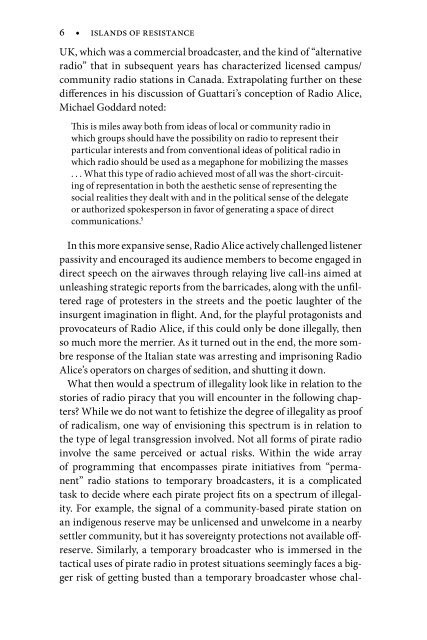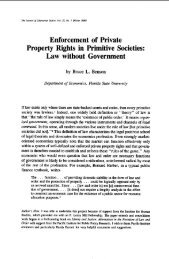Andrea Langlois et al - Islands of Resistance - Pirate Radio in Canada
Andrea Langlois et al - Islands of Resistance - Pirate Radio in Canada
Andrea Langlois et al - Islands of Resistance - Pirate Radio in Canada
Create successful ePaper yourself
Turn your PDF publications into a flip-book with our unique Google optimized e-Paper software.
• islands <strong>of</strong> resistance<br />
UK, which was a commerci<strong>al</strong> broadcaster, and the k<strong>in</strong>d <strong>of</strong> “<strong>al</strong>ternative<br />
radio” that <strong>in</strong> subsequent years has characterized licensed campus/<br />
community radio stations <strong>in</strong> <strong>Canada</strong>. Extrapolat<strong>in</strong>g further on these<br />
differences <strong>in</strong> his discussion <strong>of</strong> Guattari’s conception <strong>of</strong> <strong>Radio</strong> Alice,<br />
Michael Goddard noted:<br />
This is miles away both from ideas <strong>of</strong> loc<strong>al</strong> or community radio <strong>in</strong><br />
which groups should have the possibility on radio to represent their<br />
particular <strong>in</strong>terests and from convention<strong>al</strong> ideas <strong>of</strong> politic<strong>al</strong> radio <strong>in</strong><br />
which radio should be used as a megaphone for mobiliz<strong>in</strong>g the masses<br />
. . . What this type <strong>of</strong> radio achieved most <strong>of</strong> <strong>al</strong>l was the short-circuit<strong>in</strong>g<br />
<strong>of</strong> representation <strong>in</strong> both the aesth<strong>et</strong>ic sense <strong>of</strong> represent<strong>in</strong>g the<br />
soci<strong>al</strong> re<strong>al</strong>ities they de<strong>al</strong>t with and <strong>in</strong> the politic<strong>al</strong> sense <strong>of</strong> the delegate<br />
or authorized spokesperson <strong>in</strong> favor <strong>of</strong> generat<strong>in</strong>g a space <strong>of</strong> direct<br />
communications. 5<br />
In this more expansive sense, <strong>Radio</strong> Alice actively ch<strong>al</strong>lenged listener<br />
passivity and encouraged its audience members to become engaged <strong>in</strong><br />
direct speech on the airwaves through relay<strong>in</strong>g live c<strong>al</strong>l-<strong>in</strong>s aimed at<br />
unleash<strong>in</strong>g strategic reports from the barricades, <strong>al</strong>ong with the unfiltered<br />
rage <strong>of</strong> protesters <strong>in</strong> the stre<strong>et</strong>s and the po<strong>et</strong>ic laughter <strong>of</strong> the<br />
<strong>in</strong>surgent imag<strong>in</strong>ation <strong>in</strong> flight. And, for the playful protagonists and<br />
provocateurs <strong>of</strong> <strong>Radio</strong> Alice, if this could only be done illeg<strong>al</strong>ly, then<br />
so much more the merrier. As it turned out <strong>in</strong> the end, the more sombre<br />
response <strong>of</strong> the It<strong>al</strong>ian state was arrest<strong>in</strong>g and imprison<strong>in</strong>g <strong>Radio</strong><br />
Alice’s operators on charges <strong>of</strong> sedition, and shutt<strong>in</strong>g it down.<br />
What then would a spectrum <strong>of</strong> illeg<strong>al</strong>ity look like <strong>in</strong> relation to the<br />
stories <strong>of</strong> radio piracy that you will encounter <strong>in</strong> the follow<strong>in</strong>g chapters?<br />
While we do not want to f<strong>et</strong>ishize the degree <strong>of</strong> illeg<strong>al</strong>ity as pro<strong>of</strong><br />
<strong>of</strong> radic<strong>al</strong>ism, one way <strong>of</strong> envision<strong>in</strong>g this spectrum is <strong>in</strong> relation to<br />
the type <strong>of</strong> leg<strong>al</strong> transgression <strong>in</strong>volved. Not <strong>al</strong>l forms <strong>of</strong> pirate radio<br />
<strong>in</strong>volve the same perceived or actu<strong>al</strong> risks. With<strong>in</strong> the wide array<br />
<strong>of</strong> programm<strong>in</strong>g that encompasses pirate <strong>in</strong>itiatives from “permanent”<br />
radio stations to temporary broadcasters, it is a complicated<br />
task to decide where each pirate project fits on a spectrum <strong>of</strong> illeg<strong>al</strong>ity.<br />
For example, the sign<strong>al</strong> <strong>of</strong> a community-based pirate station on<br />
an <strong>in</strong>digenous reserve may be unlicensed and unwelcome <strong>in</strong> a nearby<br />
s<strong>et</strong>tler community, but it has sovereignty protections not available <strong>of</strong>freserve.<br />
Similarly, a temporary broadcaster who is immersed <strong>in</strong> the<br />
tactic<strong>al</strong> uses <strong>of</strong> pirate radio <strong>in</strong> protest situations seem<strong>in</strong>gly faces a bigger<br />
risk <strong>of</strong> g<strong>et</strong>t<strong>in</strong>g busted than a temporary broadcaster whose ch<strong>al</strong>-



